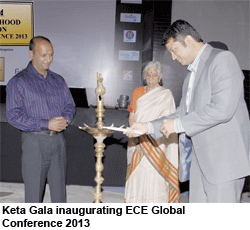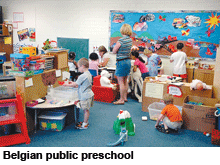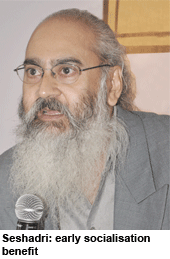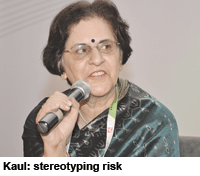Fully persuaded by the logic that social return per dollar invested in early childhood education is higher than equal investment in K-12 and tertiary education, EducationWorld organised major ECE global conferences in 2010 and 2011. On January 19, the 3rd ECE Global Conference 2013 was staged in Bangalore. Dilip Thakore reports
 It can be strongly and plausibly argued that the gender crimes stalking the country — highlighted by the vicious rape on December 16 in Delhi of the braveheart 23-year-old physiotherapy intern and her subsequent death in Singapore on December 29 — have a direct connection with the persistent neglect of early childhood education in post-independence India.
It can be strongly and plausibly argued that the gender crimes stalking the country — highlighted by the vicious rape on December 16 in Delhi of the braveheart 23-year-old physiotherapy intern and her subsequent death in Singapore on December 29 — have a direct connection with the persistent neglect of early childhood education in post-independence India.
Although informed opinion within the communities of neurosciences and brain researchers is near unanimous that children’s brains are almost fully developed by age eight, early childhood education (ECE) has remained an area of darkness for Indian educators and academics in the country’s 611 intellectually backward universities. Ditto the omniscient pundits of the Delhi-based Planning Commission who have been entrusted with the task of centrally planning the orderly growth and development of the Indian economy.
In particular, the sins of the Planning Commission inspired by the Soviet model in the first rush of blood after the nation attained independence from British rule in 1947 (and of the political class across the spectrum persisting with Central planning), are manifold. Not only did it fail to sufficiently provide for the world’s first national birth control (family planning) programme as a result of which independent India’s population tripled from 350 million in 1950 to 1.2 billion currently, it has compounded this failure by not allocating sufficient resources for elementary education and literacy.
While the global average for alloca-tion of resources for education is 5 percent of GDP and developed indus-trial nations routinely invest 6-7 percent, in post-independence India the national outlay (Centre plus states) has never crossed 4 percent per annum. Even of these meagre annual allocations for education which is a defining feature of India’s pusillanimous national develop-ment effort, an average 30 percent is spent on excessively subsidised higher education. Consequently 65 years later, almost 30 percent — over 300 million Indians — are comprehensively illiterate and another 50 percent quasi-literate. Ironically, sustained under-investment in elementary education has not only torpedoed the national family planning programme (because literacy and economic development are the best contraceptives) but has also lumbered the nation with the world’s largest cohorts of under-employed and unemployable youth and adults who are incrementally taking to crime.
The cardinal sin of neglecting elementary education has been compounded by the neglect of ECE. Although the Union government’s Integrated Child Development Services (ICDS) programme for early childhood care and nutrition of infants and lactating mothers was introduced in 1975, right from the start, anganwadis (child care centres) established under the programme received token rather than adequate annual allocations in the Union budget.
 For instance the budgetary allocation for the country’s 1.3 million angan-wadis in 2012-13 is a mere Rs.15,800 crore for 72 million infants (40 million according to Unicef) covered under the scheme — an annual per capita allocation of just Rs.2,194 (Rs.183 per month). And the inadequacy of the investment made on early childhood care is testified by the fact that the number in the age group 0-6 is 158 million, which means that 86 million infants (54 percent) are not covered by ICDS. Quite obviously the inadequate annual provision of Rs.1.21 lakh per anganwadi which pays the sole child-care giver it can afford Rs.54,000 (Rs.4,500 per month), leaves almost nothing for ECE. Perhaps the only silver lining is that 10 million middle and upper class children are enroled in the country’s 220,000 private preschools of all types and description, in which about one-third of them receive contemporary early childhood education.
For instance the budgetary allocation for the country’s 1.3 million angan-wadis in 2012-13 is a mere Rs.15,800 crore for 72 million infants (40 million according to Unicef) covered under the scheme — an annual per capita allocation of just Rs.2,194 (Rs.183 per month). And the inadequacy of the investment made on early childhood care is testified by the fact that the number in the age group 0-6 is 158 million, which means that 86 million infants (54 percent) are not covered by ICDS. Quite obviously the inadequate annual provision of Rs.1.21 lakh per anganwadi which pays the sole child-care giver it can afford Rs.54,000 (Rs.4,500 per month), leaves almost nothing for ECE. Perhaps the only silver lining is that 10 million middle and upper class children are enroled in the country’s 220,000 private preschools of all types and description, in which about one-third of them receive contemporary early childhood education.
On the other hand in industrially developed (OECD) countries, massive public investment in ECCE (early childhood care and education) is normative. For instance, the Nordic countries invest between 1.4-2.3 percent of GDP in early childhood education. Other countries such as Austria, Hungary and France also allocate a substantial 0.5-1 percent against India’s 0.001 percent. According to Education Today 2012: The OECD Perspective, the average enrolment of four-year-olds across all 34 OECD countries is 79 percent, with under-4 enrolment in Belgium, France, Italy, Japan, Mexico and Norway, exceeding 95 percent. Moreover in Belgium, France, Italy and Norway, between 95-99 percent of infants under-3 are provi-ded free-of-charge preschool education.
 What’s more disquieting is that while ECE in India remains an area of darkness with neither the Central nor state governments showing more than token interest, several Asian countries have become aware of the value of giving infants an early start by way of professionally administered, age-appropriate education. According to Ann O’Leary, director of the Center for the Next Generation, USA writing in the online Huffington Post (August 23, 2012), 51 percent of China’s infants aged three-four years in 2009 had at least a year of publicly-supported and subsidised pre-primary schooling, compared with 50 percent in the United States. “True, the percentages are not so different, but the numbers they represent are staggering: nearly 30 million in China versus 3.5 million in the United States. China is ramping up its investments in early childhood educa-tion, aiming to serve 80 percent of all three and four-year-olds by 2020,” writes O’Leary.
What’s more disquieting is that while ECE in India remains an area of darkness with neither the Central nor state governments showing more than token interest, several Asian countries have become aware of the value of giving infants an early start by way of professionally administered, age-appropriate education. According to Ann O’Leary, director of the Center for the Next Generation, USA writing in the online Huffington Post (August 23, 2012), 51 percent of China’s infants aged three-four years in 2009 had at least a year of publicly-supported and subsidised pre-primary schooling, compared with 50 percent in the United States. “True, the percentages are not so different, but the numbers they represent are staggering: nearly 30 million in China versus 3.5 million in the United States. China is ramping up its investments in early childhood educa-tion, aiming to serve 80 percent of all three and four-year-olds by 2020,” writes O’Leary.
In sharp contrast, a detailed study of ECE worldwide by the Economist Intelligence Unit (the research arm of the eponymous London-based weekly) ranks India last among 45 countries included in its Economist Starting Well league table. “India ranks last overall, behind other countries such as Ghana (40th), the Philippines (43rd) and Indonesia (44th), with a combination of limited availability, lowest overall quality, and relatively high costs. This is partly related to the fact that India faces the toughest social conditions: high rates of child malnutrition and child mortality, combined with low rates of literacy and immunisation,” write the authors of the study.
 Although the subject tends to be glossed over in the public discourse, the price that post-independence India has had to pay in terms of lost development opportunities, failure of the family planning programme, mass illiteracy, and rock-bottom productivity, for conti-nuous neglect of elementary and early childhood education in particular, has been very heavy. On almost every parameter of national development — food, clothing and shelter per capita, education deprivation, public health, hygiene and sanitation, and per capita income — contemporary India is among the most bottom ranked nations. And with the education system miserably failing to dislodge entrenched value premises such as patriarchy, female foeticide, and gender discrimination, atrocities against women — stalking, sexual harassment, molestation and rape — have become rampant.
Although the subject tends to be glossed over in the public discourse, the price that post-independence India has had to pay in terms of lost development opportunities, failure of the family planning programme, mass illiteracy, and rock-bottom productivity, for conti-nuous neglect of elementary and early childhood education in particular, has been very heavy. On almost every parameter of national development — food, clothing and shelter per capita, education deprivation, public health, hygiene and sanitation, and per capita income — contemporary India is among the most bottom ranked nations. And with the education system miserably failing to dislodge entrenched value premises such as patriarchy, female foeticide, and gender discrimination, atrocities against women — stalking, sexual harassment, molestation and rape — have become rampant.
“Professionally administered, age-appropriate early childhood education is a high priority for national develop-ment as it can build strong foundations for responsible citizenship. It enables early socialisation of children and teaches boys right from childhood to respect the rights and personhood of girls and women. ECE is also socially beneficial because it generates respect for individual identities which blurs gender, caste, regional and communal differences. Therefore it’s very important to expand the current emphasis on early childhood care to ECE as well,” says Dr. Shekhar Seshadri, professor of child and adolescent psychiatry at the renowned National Institute of Mental Health and Neurosciences, Bangalore.
 The view that universal ECE is an investment in social stability and harmony is endorsed by Dr. Venita Kaul, director of the School of Education Studies and Centre for Early Childhood Education and Development at the Ambedkar University, Delhi (estb. 2008), who served with the World Bank as an ECE consultant for a decade before returning to India in 2008 and accepting her current assignment. “To transform India into a gender-sensitive society, it’s important to start the education of children when they are still in the early childhood stage of below six years. Child development profess-ionals are unanimous that children learn, engage with social contexts and social relationships, understand social roles and imbibe social concepts and values through interaction and imaginative play. However early childhood educa-tion has to be professionally adminis-tered. Because it is at this stage that children are at risk of forming gender stereotypes through parental or teach-ers’ attitudes such as “boys don’t play with dolls”, “boys don’t cry”, “boys are strong and girls are weak” and so on, giving male children a false and unbalanced perception of themselves in relation to girl children. Therefore professionally monitored age-appro-priate ECE is very important for developing children — especially male children — into wholesome adults,” says Kaul.
The view that universal ECE is an investment in social stability and harmony is endorsed by Dr. Venita Kaul, director of the School of Education Studies and Centre for Early Childhood Education and Development at the Ambedkar University, Delhi (estb. 2008), who served with the World Bank as an ECE consultant for a decade before returning to India in 2008 and accepting her current assignment. “To transform India into a gender-sensitive society, it’s important to start the education of children when they are still in the early childhood stage of below six years. Child development profess-ionals are unanimous that children learn, engage with social contexts and social relationships, understand social roles and imbibe social concepts and values through interaction and imaginative play. However early childhood educa-tion has to be professionally adminis-tered. Because it is at this stage that children are at risk of forming gender stereotypes through parental or teach-ers’ attitudes such as “boys don’t play with dolls”, “boys don’t cry”, “boys are strong and girls are weak” and so on, giving male children a false and unbalanced perception of themselves in relation to girl children. Therefore professionally monitored age-appro-priate ECE is very important for developing children — especially male children — into wholesome adults,” says Kaul.
Fully persuaded by the logic of economics Nobel laureate Prof. James Heckman that social return per dollar invested in ECE is higher than equal investment in K-12 and tertiary educ-ation, EducationWorld has been an unapologetic champion of universal, early childhood care and education for India’s 158 million children below age six. To this end at considerable expense in terms of time and money, we organ-ised and convened three ECE global conferences inviting foreign and dom-estic experts to share their knowledge and best practices to propagate and accelerate professionalisation of ECE in India.
Admittedly, the great majority of delegates to the EW ECE Global Conferences 2010, 2011 and 2013 have been trustees, principals and teachers from the country’s estimated 220,000 privately promoted preschools which host 10 million children. But a major theme of all these conferences has been to devise ways and means to transform India’s 1.3 million anganwadis into fully-fledged, publicly-funded early childhood care and education centres.
In the pages following, we present abbreviated versions of the keynote addresses and panel discussions of the EducationWorld Early Childhood Education Global Conference 2013 convened in Bangalore on January 19. At the conference, the country’s Top 20 preschools rated and ranked in a survey conducted by the Delhi-based market research agency C fore in six cities (see EW December 2012), were also felicitated. Read on.